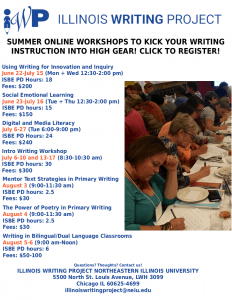Writing to learn removes barriers that formal assessment might place in the way of creative thought and exploration. Writing to learn activities are spontaneous, short, exploratory, expressive, informal, personal, unedited, and ungraded. This is much like what we expect brainstorming or pre-writing to be. We can use writing to explore and muddle through complicated new ideas at both pre-writing and writing beyond the content.
Two tools discussed here are clustering and concept mapping.
Clustering
Clustering is a form of writing-to-learn using a kind of right-brained outlining first described by Gabrielle Rico in her book Writing The Natural Way (Tarcher, 1985).
- Start with a key concept, term, or name in a circle at the center of a page.
- Draw spokes radiating out from the center circle.
- Through free-association, jot down all the ideas in circles arrayed at the end of the spokes, in whatever pattern “seems right.”
- Add more spokes as ideas lead to further thoughts and connections.
For Pre-Writing. For creative writing, this topic might be a self-selected, perhaps one from a previous writing. As an entry point into a lesson, it might be a concept suggested by the instructor. Writers can then use this diagram as an outline or list of subtopics they wish to cover. Then, they can use scaffolding that leads to the issue that they really want to focus on. It can be a guide to a group of issues related to one another in one region of the diagram.
For Writing Beyond the Content. Clustering helps writers see how all the main ideas and details in a unit of study are connected together. In addition, clustering often reveals unrecognized connections and relationships. 
Concept Mapping
Concept mapping, originating with Joseph Novak and Alberto J. Cañas, depends on relevant relationships among the ideas on the page. This method is especially helpful for writers who are trying to learn and write about larger subject areas.
- Begin with a list of subtopics, cause-effect relationships, or whatever aspects of their topics are relevant.
- Add words and phrases to the list, drawing connections to other items.
- Label lines (connections) to explain how the two items are related.
For Pre-Writing. The relationships identified among the topics generated in a concept mapping session can springboard a writer into inquiry (What other connections might there be? Why are these two items connected?) or creative writing (What do I have to say about these connections?)
For Writing Beyond the Content. Identifying relationships among concepts moves writers beyond the day’s lesson or week’s mini-unit. Encouraging writers to think about the crossovers in their lives (other content areas, extra-curricular, family, community, and world) enhances understanding of the concept. Fire up those synapses!
Going Digital A Google search for digital brainstorming or mind mapping tools will populate your screen with countless options. I have had success with digital tools Padlet or Popplet because they are so easy to use.
Resources provided by the Illinois Writing Project Basic 30 Team. Don’t forget to check out the IWP on Twitter!




 Some poems take the form of “direct address”—that is, the speaker in the poem talks directly to a specific person. Poems can be used to develop initial reactions to situations or current events or as extensions of
Some poems take the form of “direct address”—that is, the speaker in the poem talks directly to a specific person. Poems can be used to develop initial reactions to situations or current events or as extensions of